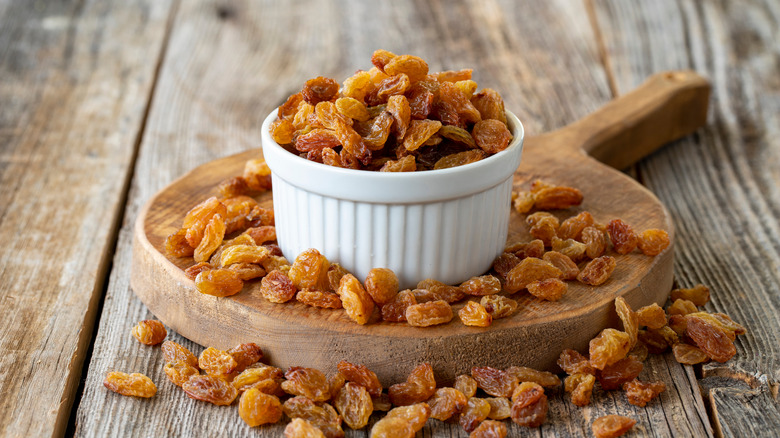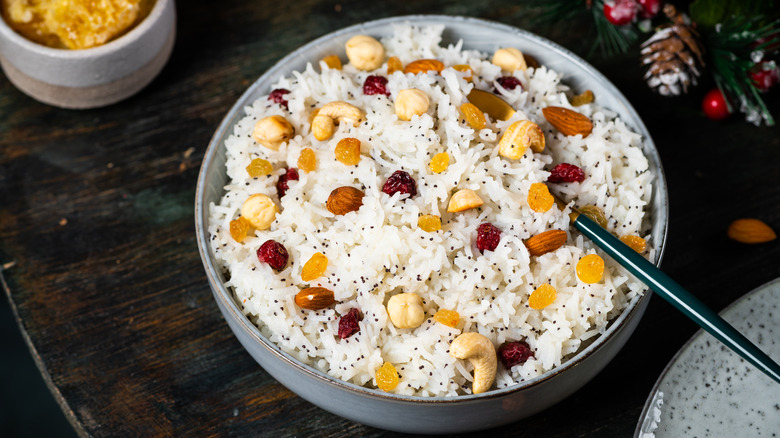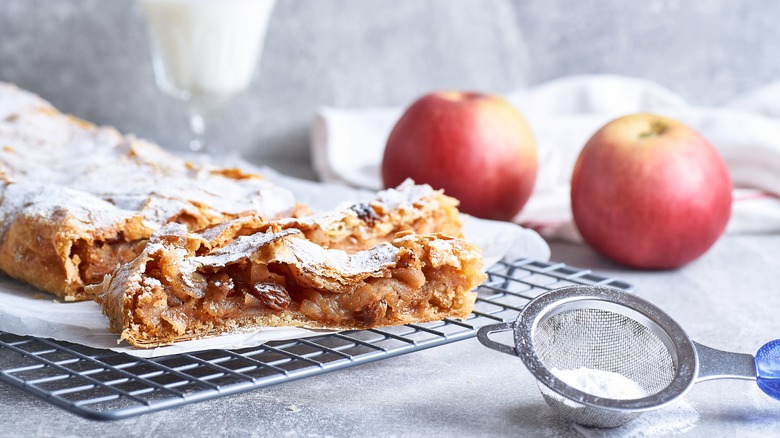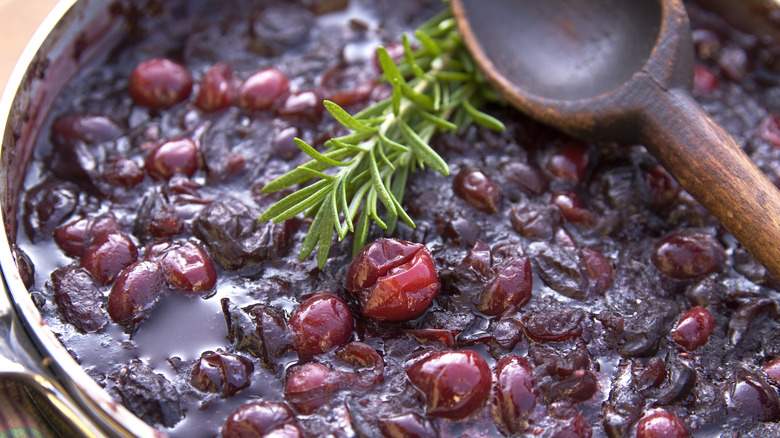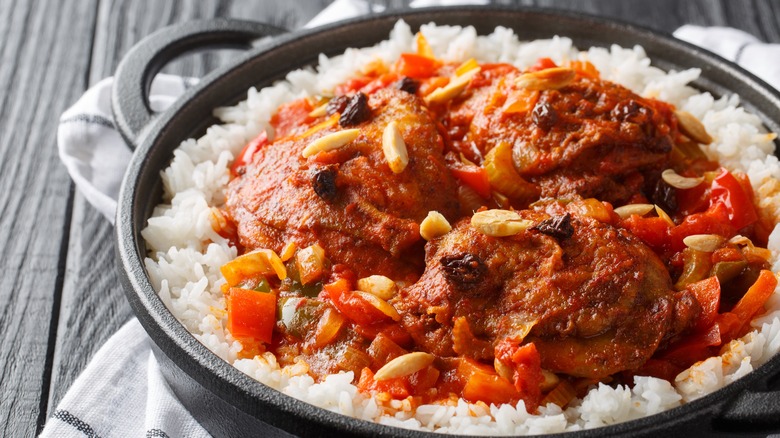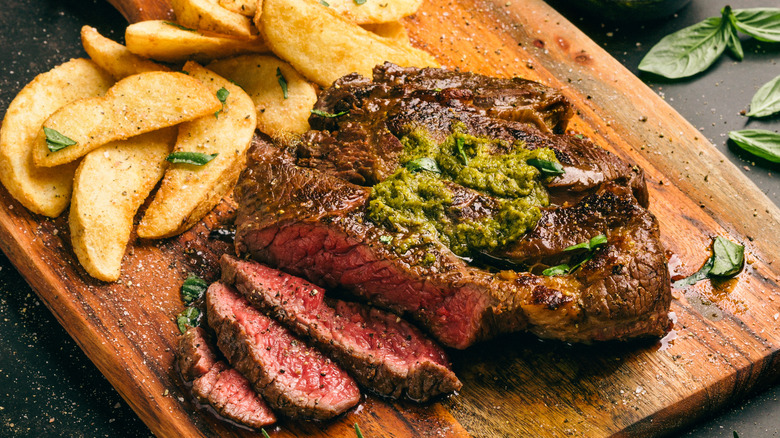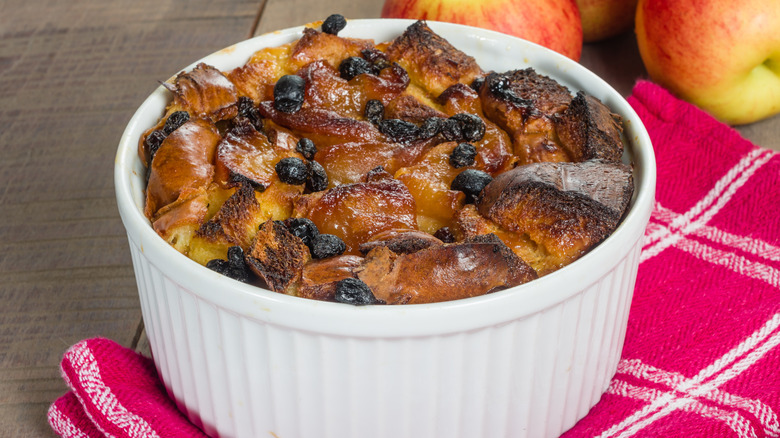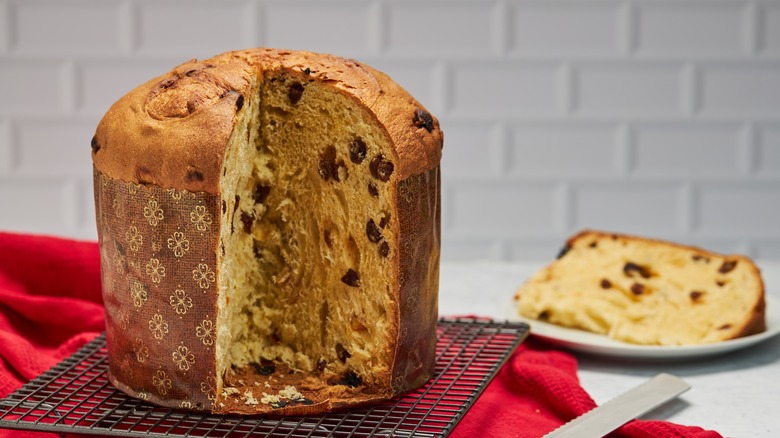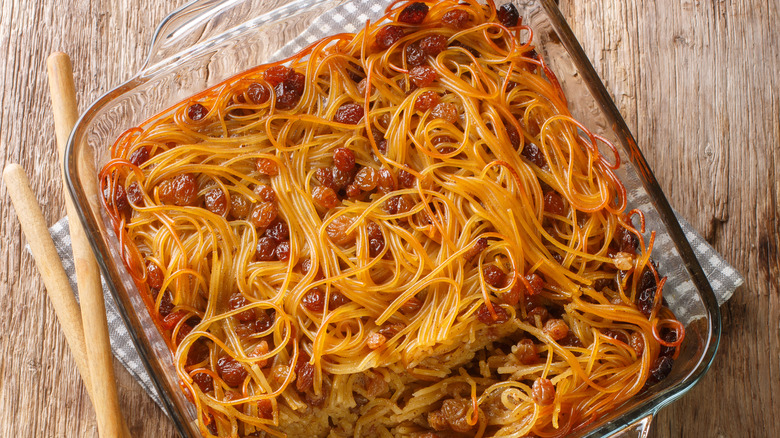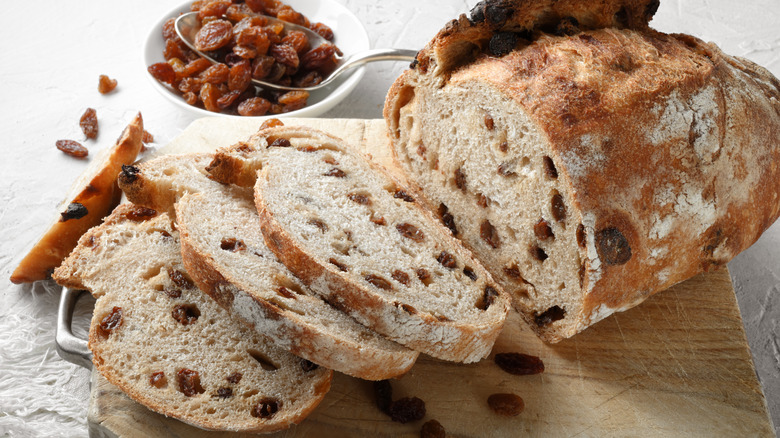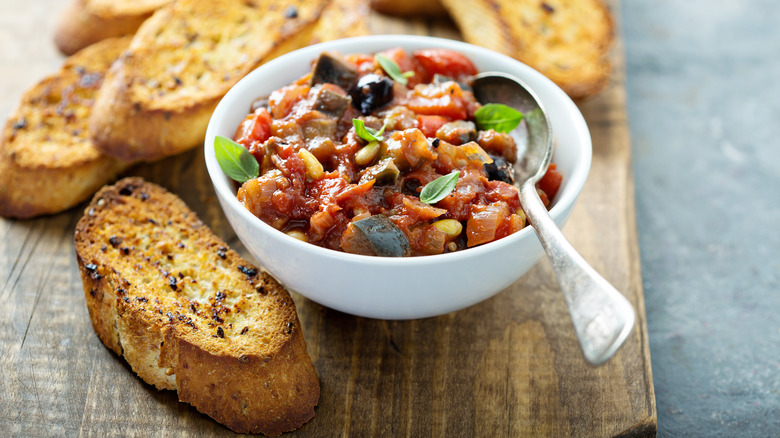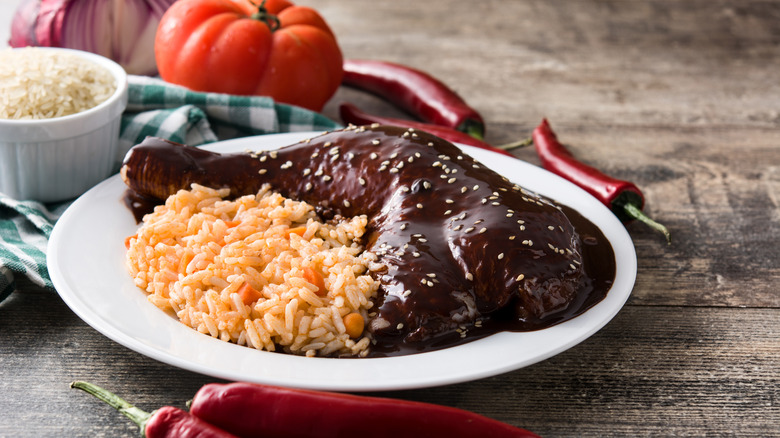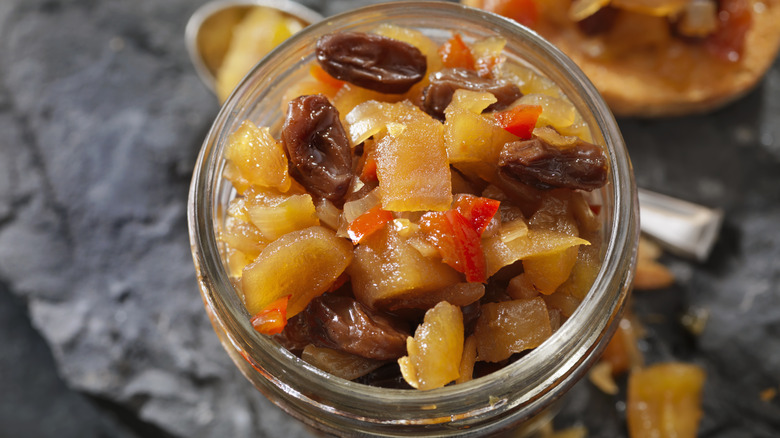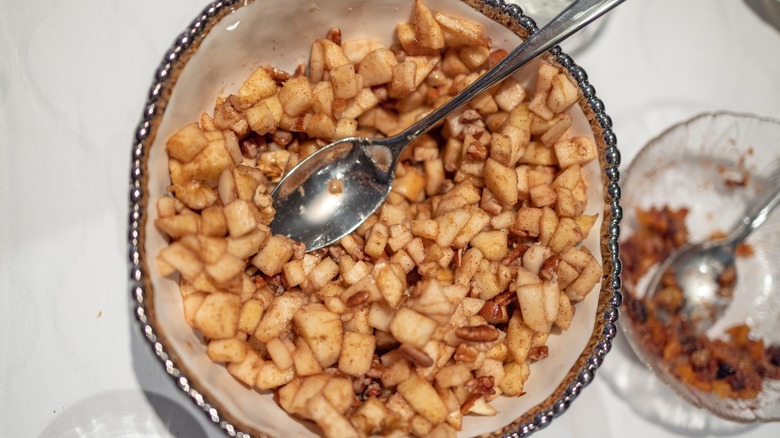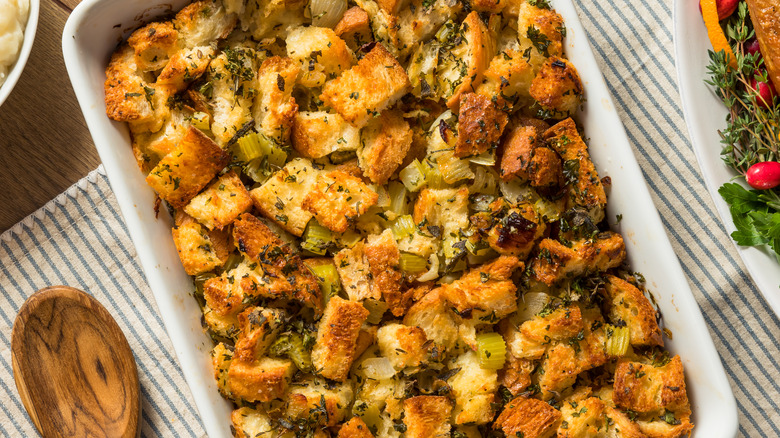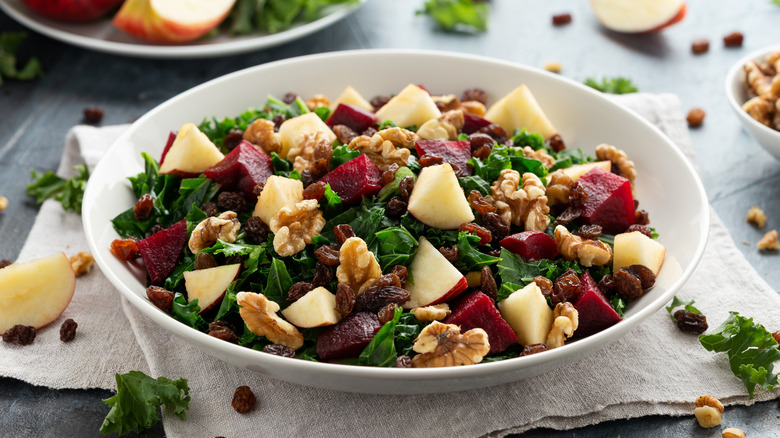17 Ways To Use Raisins In Cooking
Raisins can have a bad reputation. The dried fruit may conjure up images of biting into what you thought was a chocolate chip cookie, only for it to be a disappointing oatmeal raisin cookie. Or maybe you have memories of digging through your bag of trick-or-treat candy excited for a chocolate bar, when you found an unwanted box of Sun-Maid.
Personal tastes aside, raisins are simply dried fruits made from sun-drying or dehydrated grapes. They have been around for thousands of years and have contributed to cuisines across the globe. But recently, the demand has been dwindling. As of 2019, the raisin industry is worth approximately $500 million, but research suggests millennials are consuming fewer raisins than generations before them, according to The New York Times.
To combat this, raisin companies have worked to increase their product creativity, target millennials in advertising, and find new and interesting ways to promote using their products — all to convince consumers they're worth a spot in their pantry. After all, raisins bring great texture, sweetness, and fruitiness to tons of different dishes.
1. Make carrot cake with pops of fruity raisins
A classic carrot cake recipe gets moisture and sweetness from grated carrots and zing from decadent cream cheese frosting. But beyond the staple ingredients, this spring favorite is a blank canvas for flavor. While some choose to add robust spices for earthiness, nuts like pecans or walnuts for crunch and flavor, or pineapple and coconut for fruitiness, one addition is a true no-brainer—raisins. The chewy texture contrasts perfectly with the dense cake and the aforementioned crunchy ingredients. Each pop of raisin also brings some much-needed moisture and sweetness throughout the cake to help balance some of the nutty and savory elements.
You can use any type of raisins you want, but Ina Garten opts for golden raisins when baking. On an episode of "Barefoot Contessa," she noted golden raisins are a "little sweeter" and look "great" in cake, compared to traditional raisins. This type of raisin is dried at controlled temperatures in large dehydrators and is treated with antioxidant sulfur dioxide. This creates a fruitier and lighter flavor great for cakes.
2. Upgrade rice dishes
You can find rice dishes on nearly any menu from all over the globe. It's a core ingredient for Japanese sushi, Spanish paella, Italian risotto, West African Jollof rice, and so much more. But some of the best dishes use contrasting flavors and textures, like sweet and salty or chewy and crunchy, for a perfect bite. To do this, many traditional recipes call on a touch of sweetness from raisins to complete a rice dish, bringing flavor balance to savory spices and herbs.
But unlike sweeteners, like honey or sugar, raisins also bring a unique textural element that contrasts crunchy nuts or firm rice. Some examples of rice dishes from around the world include Afghani Kabuli pulao, a pilaf dish with lamb and spices that is topped with carrots, raisins, and almonds, Saudi Arabian Kabsa, a spiced rice dish with chicken and raisins, and Curaçao's curried rice with raisins.
3. Top your breakfast foods
They say breakfast is the most important meal of the day, and raisins can be a surprising addition to your morning meal. Though they're not a low-calorie or low-sugar food, raisins can still add some nutritious boost to your breakfast. Raisins are packed with fiber, iron, calcium, boron, and antioxidants. The dried fruit can help relieve constipation, build strong bones, and lower your risk for heart disease, according to Healthline.
So, instead of sugary maple syrup or a time-consuming compote, raisins can be a healthier alternative to bring sweetness or fruitiness to a dish with the added bonus of chewy texture. The best way to enjoy them is to transform raisins with a little butter and salt for a truly decadent experience. This trick takes just a few minutes and turns raisins into plump, buttery, and juicy pops of flavor to finish off frozen waffles, a slice of toast, homemade pancakes, or a bowl of oatmeal.
4. Bake them into strudel
Strudels hail from central and western Europe and are well known for their delicate, flakey pastry dough and delectable fillings. Though any fruit filling is acceptable, apple strudel is likely the most popular. The sweet pastry is commonly associated with Austria and Germany and has a warming, cinnamon apple filling. It's a perfect example of a sweet-tart dessert with green apples folded into a sugary syrup of butter, sugar, and spices.
But one common addition is dried fruit — specifically raisins. Not only do the raisins soak up some of the liquid filling, but they also provide extra sweetness and a textural contrast to the crisp apples. Raisins are typically mixed in when the apples are done cooking, and they'll sit and soak up the liquids while the mixture cools. You can use any type of raisin in an apple strudel, but the longer they sit in the filling, the more plump and delicious they'll get.
5. Create infused cranberry sauce
As the grape harvest season of early fall comes to an end, cooks tend to turn to cranberries for their fall fruit needs. And though the version that is jellied from the can often found on your Thanksgiving table is common, these little red berries are exceptional when cooked fresh.
The only downside is that they tend to have an intensely tart flavor profile that requires a heavy hand when it comes to adding sugar. Instead of scooping in cup after cup of sweetener, another great option is taking your favorite raisins and cooking them into your cranberry sauce or relish. The grapes melt into the mixture, adding sweetness without all the added sugar, plus a depth of flavor in a typically one-note dish. And if you're making a relish-style cranberry sauce, pops of raisin can add a much-needed textural contrast, too. Once your raisin-infused cranberry sauce is ready, top off your holiday duck, turkey, chicken, or even your French toast brunch with the fruity concoction.
6. Rehydrate raisins in a stew
There are so many ways to use raisins in sweet dishes, but these little plump dried fruits are actually an excellent addition to savory stews, braised meats, and sauces. This technique is especially popular in Mediterranean and Middle Eastern dishes. The dried fruit pairs well with warming spices and fresh herbs popular in the cuisines of the area.
Adding dried fruit to these dishes can help thicken stews, bring a touch of sweetness, and aid in making them feel extra hearty and stick-to-your-ribs delicious. Start off with really plump, fresh raisins. Then, the trick is to rehydrate the fruit in warm water for a few minutes before adding the drained fruit to a brothy base. And don't forget about that incredible rehydrating liquid. Add some to the sauce to bring extra sweetness throughout. The final dish will have pops of soft, sweet fruit in each spoonful that contrast some of the more savory flavors of the dish.
7. Blend them into pesto
When you think bright and fresh pesto, you probably imagine blending together a bright green Italian sauce made from ingredients like basil, cheese, nuts, and olive oil. That cheesy, nutty sauce is then mixed into your favorite pasta dish. But pesto can be so much more than that. In fact, Italians have been playing with traditional pesto for centuries, adding different types of herbs, nuts, cheeses, and other ingredients. You can find pestos made from roasted red pepper, almonds, mint, spinach, and so much more.
One variation worth a try is creating a pesto that uses a variety of herbs, like parsley and mint, with raisins, like these spiced lamb meatballs with green raisin pesto. It may seem odd, but raisins can cut the intensity of pesto's often nutty and herbaceous ingredients. The raisins bring bright acidity, a touch of sweetness, and some textural integrity to the final sauce. Plus, raisin pesto pairs beautifully with not only pasta dishes but helps cut through the fattiness of many meat dishes, too, making it an extra versatile condiment.
8. Drop raisins in bread pudding
Bread pudding is a very common dessert from all over the world perfect for the holiday season or any chilly winter day. The dish starts with bread soaked in a custard of milk or cream, eggs, butter, sugar, spices, and other mix-ins. Once the bread is soggy and has soaked up the mixture, it is baked to create a spongy, thick pudding-like treat. Bread puddings take just a few minutes to throw together, are a great way to use up leftover bread, and can easily feed a crowd.
But the dessert can be incredibly rich from the cream and butter, so many bread pudding recipes opt for the addition of raisins to help cut some of the richness and bring acidity and fruitiness to the bake. For example, Britain's favorite bread pudding, called spotted dick, is a steamed bread pudding that requires raisins or currants to bring the iconic spots to the final dish. You can even add a mixture of golden and traditional raisins for more variety in flavor and color.
9. Get creative with Italian panettone
Nothing says Italian bread — especially holiday Italian bread — quite like panettone. The bread is made from a brioche base and is filled with dried and candied fruits that have been soaked in liqueur. This creates a light cake-like bread with yeasty notes and pops of sweetness. Throughout Italy, red, white, and green-colored fruits tend to decorate the dough to represent the Italian flag, but the bread is enjoyed worldwide and the colors have become representative of Christmas time.
Though you can buy Panettone in most places during the holiday season, a homemade version is quite the centerpiece. And the perfect mixture of dried fruit throughout is crucial to the ultimate bread. Gather all of your dried and candied fruits and peels in a bowl and let it soak overnight in liqueur for plump, intensely flavorful bites throughout the bread. As a bonus, a mixture of both golden and dark raisins helps to create more variety and an extra fruity flavor profile.
10. Elevate your noodle kugel
Kugels come in a variety of styles — potato, matzo, noodle, vegetable, apple, and more. But whether you grew up eating kugel at every family gathering or you saw it once at a friend's holiday party, you likely know these recipes are unique from family to family.
Noodle kugels, for example, often start with egg noodles that are baked in a custard-like liquid made from eggs, dairy products, and additional mix-ins. The ingredients vary greatly with some recipes calling for cottage cheese, sour cream, walnuts, dried fruits, pineapple, apples, and more to create the iconic sweet-and-sour casserole.
But raisins are non-negotiable for many noodle kugel connoisseurs. This is because the little nuggets of dried grapes help to absorb some of the kugel's liquid while simultaneously plumping up to provide little pops of fruity sweetness. Plus, many kugels can be quite heavy with dairy-based ingredients, and these sour, tangy bites bring some much-needed balance.
11. Give a pop of sweetness to bread
There are few things in life as universally loved as bread. We're not sure if it's the humble experience of turning flour into something that can nourish the entire family when making whole wheat bread or the meditative practice of kneading the dough and allowing it the time to rise when creating sourdough loaf. But over the last few years, we've seen a growing interest in baking bread from scratch.
And what better way to elevate your bread-baking habit than with raisins? These little dried fruits add sweetness and flavor to regular, savory breads. They can turn your homemade loaf into something for breakfast or even dessert-worthy. If you don't know where to start, raisins are traditionally used in Irish soda bread, cinnamon raisin bread, and challah bread. Simply mix them into your finished dough and bake per recipe instructions for something special that is far from bland and dry.
12. Sweeten up a classic caponata
Caponata is a stewed eggplant-based dish from Sicily similar to French ratatoille. It's best known for its sweet and sour flavors from ingredients like roasted eggplant, olive oil, garlic, red tomatoes, capers, olives, vinegar, and sugar. The key is to cook the eggplant long enough that it loses any bitterness and softens to soak up all the flavors like a sponge.
Every Italian grandmother makes a different version of this crowd-pleasing dish, with creative ingredients like red bell peppers, pine nuts, or celery. But new variations include raisins in the mix to bring that sweet and sour flavor forward. Plus, it's a great recognition of the autumn when eggplant season comes to an end and the grape harvest begins.
Serve it as a main straight out of the skillet, a side dish alongside chicken or fish, or an appetizer with some crusty bread for dipping and spreading. Some say it tastes even better the next day, so consider meal prepping this in advance for a dinner party.
13. Make a mole
This pre-Hispanic Mexican sauce is essential for every special occasion in Mexico and every region makes its own specialty version. It's typically a paste made from ingredients like dried chilies, fruit, herbs, spices, nuts, and chocolate and can be green, black, yellow, red, and many other colors. Today, it's served all over the world alongside fish, eggs, chicken, tortillas, duck, steak, and more.
But if you have a hankering for homemade Mexican food and have a bag of raisins in the cabinet, you may be in luck. One mole sauce version uses raisins, which helps to add density, texture, and sweetness. It's a great way to use up a bag of the dried fruit when feeding people who don't like raisins because they're virtually undetectable when blended into the final sauce. The raisins help to thicken the sauce while adding incredible depth of flavor that will taste like your mole has been simmering for days.
14. Mix into a rich chutney
At its core, chutney is a condiment, similar to a blended, chopped, or ground relish, that is often served with Indian dishes. It can be made from any ingredients, like herbs, chilies, spices, fruits, nuts, and dairy products, and vary in consistency, technique, and flavors. The variety of chutney comes from the vast styles of cooking across India. The condiment is mostly used to help balance out some of the more savory or spicy flavors in Indian cuisine.
In the modern day, many chutneys have become more mainstream beyond Indian cuisine. They are found in supermarkets across the globe and recipes for chutney include ingredients not typically found in India. Some fruit-forward chutneys will lean on dried fruits, like raisins, for their ability to pair beautifully with deep, savory ingredients like ginger, tamarind, and spices. They help create rich flavor and can help elevate a simple chutney. Just serve it up with your favorite dosas or samosas for a delicious treat.
15. Enjoy in charoset for Passover and beyond
Charoset is a traditional addition to the spring Passover feast, called the seder. The sweet mixture varies greatly based on where in the world the host family comes from. But, typically, charoset includes fruits, nuts, spices like cinnamon, and sweet wine. This will become either a fruit and nut salad or a sticky and candy-like bite, depending on the ingredients used, in what proportions, and the family's traditions. There is some speculation as to the exact meaning of charoset, but many believe it is meant to represent the material used by the Jews for construction in ancient Egypt.
One classic ingredient for many easy charoset recipes is raisins, which helps to keep the dish more solidified and sweet. So, whether you're hosting your own seder or you're a guest wanting to bring something special, the raisin-filled apple dish is most definitely the way to go.
16. Modernize your holiday stuffing
Whether you bake a casserole dish of dressing on the side or stuff your turkey on Thanksgiving morning, stuffing is a must for any holiday spread. It's carb-heavy, herby, and the perfect vessel to soak up all that turkey gravy and cranberry sauce. But on a plate alongside the creamy mac and cheese, heavy pumpkin pie, and fatty mashed potatoes, super bready stuffing can be a bit much.
Instead, mix in a cup of raisins to your usual stuffing for a touch of brightness, sweetness, and acid that can help balance out your plate. Start by letting the raisins soak in some warm water while you assemble the rest of the stuffing. Then, just mix the drained raisins in and bake. You can use some of the soaking liquid in place of some chicken stock for a little extra sweetness. As a bonus, the raisins soak up all that liquidy goodness to create plump pops of sweetness without crossing the too-sweet line.
17. Pickle raisins for salads
Vinegar-heavy dressings or pickled onions are classic additions to a salad. They impart some much-needed acid to balance fatty ingredients like bacon, cheese, or meats. But one unique way to add tangy notes to a salad — while using up the raisins in your pantry — is to sprinkle over pickled raisins.
This may seem odd, but they're actually quite easy to make (and delicious). Boil two parts vinegar to one part sugar with any additional spices you want and pour the mixture over raisins in a glass jar until covered with the brine. Let the mixture sit uncovered until cooled. When the raisins spend some time in vinegar, they soak up all that flavor to create a sweet, salty, and acidic bite.
Especially in the cooler months, these pickled raisins can be a warming, autumnal addition to a variety of dishes. If you have some leftover pickled raisins after lunch, add them to roasts, curries, sandwiches, and more.
